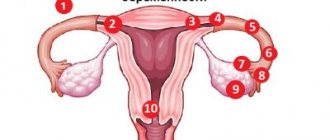Pregnancy, especially the first, raises many questions for expectant mothers, and one of them is physical activity during this period. Women wonder whether it is possible to engage in sports in their condition, and whether exotic physical activity such as yoga will harm the mother and her baby?
Most experts claim that yoga will not only do no harm, but will also help prepare for childbirth, and will also allow the woman to quickly restore her prenatal form in the future.
How is yoga beneficial for pregnant women?
Initially, it should be noted that yoga during pregnancy differs significantly from traditional exercises that are performed in the “normal state”. Exercises performed by expectant mothers - Iyengar yoga for pregnant women - involve the use of additional devices to facilitate asanas and are more aimed at:
- keep a woman in good physical shape,
- be able to relax,
- be able to control your breathing and emotions.
All this, in turn, has a beneficial effect on the psychological state of the expectant mother.
Even if a woman has not previously practiced yoga, performing the exercises will not present any particular difficulties, so you can start classes at any time (from the first weeks), but perform the exercises taking into account the current trimester.
What is recommended?
In general, yoga is not even one movement, but a whole direction. And within its framework there are divisions, some are better suited for pregnant women, others are worse. So, the instructors themselves ask you to pay attention to Kundalini yoga for pregnant women in the 1st trimester, and if it is suitable, then you can practice it at least until the birth of the child.
This direction got its name because of the importance of harmony between spirit and body and the unlocking of potential. Appropriate exercises help a woman escape from nervous and sad thoughts and fears. Instead, the pregnant woman dives inside herself and begins to listen better to her own body.
What can serve as a contraindication to yoga during pregnancy?
Before starting yoga classes, be sure to consult with your doctor who is managing your pregnancy, do you have any contraindications in this regard?
If there are any restrictions or possible contraindications, please inform your trainer - he will select exercises that will not harm you or your unborn baby, and will create an individual program for you.
What can serve as contraindications for yoga?
There are a number of unconditional contraindications, and the main ones are:
- A doctor’s prohibition based on the general unstable condition of the pregnant woman, or the threat of miscarriage.
- Miscarriages in previous attempts to become pregnant.
- Severe early toxicosis with weight loss.
- Difficult pregnancy.
- Bleeding of varying intensity.
- Polyhydramnios.
- Concomitant somatic diseases.
- Tachycardia, dizziness.
- Last week of pregnancy.
If there are such reasons, do not endanger your health and the health of your baby. Wait until you give birth and then you can start (or continue) yoga.
Recommended yoga complex in the 1st trimester - assanas in the early stages
The following yoga poses (asanas) are most beneficial for the woman’s body and fetus in the first trimester:
Table Pose
Allows you to strengthen the muscles, primarily the abdominal cavity, which will prevent the appearance of stretch marks at a later stage of pregnancy. This asana also helps get rid of sudden fatigue, increases blood flow to the brain structures and normalizes the production of necessary hormones.
It should be done this way:
- Get on all fours, leaning on the floor with your hands and knees (take the shape of a “table”). Next, inhale and carefully lift your right leg, keeping it horizontal. Extend your entire left arm forward, straightening your fingers, and then exhale.
- Maintain this position for some time (up to 3-6 phases of inhalation and exhalation).
- When exiting the pose, you need to slowly exhale the air and return to the original “table” position. Next, repeat the same pose, but with the left leg and, accordingly, with the right arm. The total number of paired repetition cycles can be increased to three.
Puppy pose
Promotes the disappearance of attacks of nausea and thus minimizes the manifestations of toxicosis. Also, in this position, the thigh muscles are worked out and painful pulling sensations in the uterus are eliminated.
The asana is performed as follows:
- Take a position on all fours, with your hips over your knees and your shoulders over your wrists. Then you need to stretch forward while straightening your arms completely. The toes should be tucked inward.
- While inhaling deeply, slowly pull your buttocks back, almost sitting down on your heels. Continue to extend your arms.
- Lower your forehead as far down as possible - onto a mat or pad. Press your palms to the floor and stretch with your arms, and pull your hips towards your heels.
- Hold the pose for 30-60 seconds, to exit it, slowly lower your pelvis onto your heels.
Happy Child Pose
Quickly promotes relaxation and relief from nausea, improves the condition of the uterus. Performed in the following order:
- Lie on your back, raise your legs and grab your feet with your hands. Pull your knees towards your armpits.
- Stretch your heels up towards the ceiling, continuing to support your feet with your hands.
- Stay in this position for a minute, then slowly lower your feet onto the mat to exit.
Deadbolt pose
Works the lateral muscles of the body, relieves pain caused by an enlarged uterus. Saturates with oxygen and fills with the necessary energy. The procedure for it is as follows:
- Kneel down, pull your right leg to the side (i.e. to the right), press your foot firmly to the floor. The body should not be turned - you need to look forward.
- Raise your left arm above your head and bend it towards your right leg. The right leg should be lowered at the same time onto the outer side of the right thigh, moving it as low as possible.
- Remain motionless in this position for 30 to 60 seconds. Then, while inhaling, you need to rise, straightening your left arm, and take a vertical position. Repeat all movements, only on the other side.
Whole Big Toe Pose
Designed to stretch the thigh muscles and develop the hip joints. Suitable specifically for the first trimester, since at a later stage it is by no means advisable for a woman to lie on her back. Done this way:
- Lie on your back, carefully lift your right leg. Bend your left knee and turn to the side. With your right hand, grasp your big toe firmly on your right foot. In this case, the other (left) hand should be on the left thigh.
- Stretch your right leg further to the side, while breathing deeply.
- Hold this pose for several breathing cycles. Repeat the same movements, but for the other side of the body.
King pose
Useful for the hip flexor muscles, promotes blood circulation in the chest, as well as in the stomach area. The procedure for this pose is as follows:
- Lie on your side, while supporting your head comfortably with your left hand. Next, bend your knees and grab the ankle of your right leg with your right hand.
- Press down on the foot with the palm of your hand to further stretch the muscles of the shoulder and hip. The output voltage should be increased.
- Stay in this position for 30-60 seconds, then lower your leg. Repeat, but for the other side of the body.
Cat pose
Helps eliminate pain in the uterus and back, and relieve the urge to nausea or vomiting. Performed in this order:
- Get on your knees, rest your palms firmly on the floor.
- Make sure your knees and palms are shoulder-width apart. In this position, slowly bend your back and hold for 10 seconds. Breathing should be even at this time.
- Round your back, rest a little and perform a few more (3-5 repetitions).
Features of yoga for pregnant women
To better understand how yoga for pregnant women differs from regular yoga, it must be said that yoga originates from Indian culture, where a complex of spiritual, physical and psycho-emotional practices is cultivated, which are aimed at achieving harmony and balance of the body as a whole and its unity with nature .
The state of pregnancy is the most appropriate moment for a woman to learn to accept her new position and at the same time be in harmony with herself.
Yoga for pregnant women is a lightweight version of yoga that eliminates potentially dangerous poses that could harm a woman or her baby, and even moreover, thanks to carefully selected asanas (postures), it will smoothly, step by step prepare the expectant mother’s body for childbirth.
Particular attention in yoga is paid to breathing techniques, because correct, deep breathing is one of the most important conditions for feeding the fetus with oxygen and its full development. Each trimester of pregnancy has its own set of exercises, and we will explain why this is so in separate sections of the article.
A professional and experienced yoga instructor will always ask the woman in detail about:
- How is her pregnancy going?
- are there any contraindications for starting classes,
- whether she had experience with yoga before pregnancy.
This is far from idle curiosity, but a stage in the development of an individual training program, which is based on the level of preparation of the pregnant woman and her state of health.
If you have started classes, then you need to attend them regularly, and not occasionally, since rare classes will not only not have a positive effect, but can also worsen the woman’s condition, because in this case, physical activity will be unnecessary stress for the body.
Yoga for pregnant women has 4 main stages of classes:
- yoga 1st trimester (up to 16 weeks),
- yoga 2nd trimester (from 16 to 30-34 weeks),
- yoga 3rd trimester (from 34-35 weeks),
- postnatal yoga, which helps a woman recover after childbirth and organize the work of all her vital organs in the same way.
For those who have previously practiced yoga, have some experience and are planning to continue (or resume) their classes (perhaps independently, at home), it is still worth noting that during pregnancy it is necessary to pay attention to some safety rules, or rather even precautions:
- It is not advisable to train on a full stomach (meal no later than 1.5-1 hour before class), and it is important to empty your bladder before starting class.
- For asanas, it is advisable to use auxiliary materials, for example, a bolster, pillow, blanket or bolster.
- Breathing exercises are best performed while sitting on a chair.
- Try to move smoothly (especially lying down and getting up), carefully change position, because any sudden movements (jumping, jumping) can negatively affect your condition.
- Avoid asanas that cause discomfort or pressure in the abdominal area, as well as poses that require bending back from a lying position or deep bending forward.
- If your child is too active and moves around during classes, this is a reason to stop classes. When repeating your baby’s activity during classes, observe which poses seem uncomfortable to him (when he begins to behave too actively), and then eliminate these exercises.
- If you feel excessive tension or fatigue during exercise, stop training - you should not try too hard, because exercise should bring joy and pleasure, and not exhaust.
- In the 3rd trimester, try to limit positions or time spent lying down. This is due to the fact that in this position the vena cava is bent and blood circulation worsens, and this can have a bad effect on the condition of the baby and the well-being of the mother herself.
- Since the 3rd trimester is considered the most traumatic, the exercises must be performed with additional support, and exiting the asana slowly and smoothly.
More on the topic
Yoga for pregnant women
When and how can you start doing yoga after giving birth?
Exercising During Pregnancy: Tips and Warnings
Is it possible to do bodyflexing during pregnancy?
When can you start exercising after giving birth?
Yoga in early pregnancy (1st trimester)
Yoga in early pregnancy:
- will reduce the manifestations of toxicosis (nausea, dizziness, headaches) and pain in the lower abdomen,
- reduce drowsiness,
- will help cope with feelings of fatigue and weakness, apathy and fear.
In addition, it will allow you to stabilize not only your physical, but also your emotional state, since classes during this period focus on breathing exercises, and they are aimed at relaxation, relaxation, and awareness of your new position.
By doing yoga during pregnancy, a woman will learn:
- It is right to relax, while gaining peace of mind and a sense of harmony.
- Will master breathing techniques for correct behavior during contractions during labor.
- Will be able to control your weight from the beginning of pregnancy.
- Learn proper breathing, which will provide the body with oxygen saturation and prevent the development of fetal hypoxia.
- It will prepare the body for childbirth by learning to unload the spine and muscles, which in turn will help get rid of fatigue and add elasticity and pliability to joints, tissues and organs.
Yoga Nidra asanas for pregnant women can ideally cope with these tasks.
However, under certain circumstances, in the early stages of pregnancy, yoga may be contraindicated, especially if you have never practiced yoga before. In this case, the instructor may suggest postponing the start of classes until the second trimester - until the pregnancy itself is “consolidated” and all the baby’s organs are already formed. Until the time you can start classes, just spend time in a calm, familiar environment - rest, relax, walk in the fresh air.
Yoga in the 2nd trimester of pregnancy
From 16 to 30-34 weeks, the active period of pregnancy begins, when all the unpleasant sensations and symptoms are behind you and, during the normal course of the process, you need to try to move more, learn to control your body, establish contact with the baby and accumulate strength and energy.
When doing yoga in the 2nd trimester, you need to take into account the convenience and comfort of the baby, and this should come first. All exercises should be enjoyable and beneficial, and therefore it would be useful to use special rollers or the help/support of a partner.
In addition, classes should be systematic (only then will they be beneficial), but at the same time they should not be too long.
By trimester
Regular meditation adapts a woman to a new state. The birth of human life takes place inside. Therefore, it is important to establish contact with the baby.
It is better to do yoga during pregnancy in the morning
. This is the time the body awakens. After breathing exercises, you have energy for the whole day.
But practicing yoga during pregnancy before bed in the evening
improves mental state. Breathing is restored. Sleep becomes restful.
By the end of the first trimester, the baby's organ systems are developing. Therefore, a pregnant woman is recommended to monitor her emotional state, nutrition and physical activity. You cannot lift more than 3 kg, eat spoiled foods, or be nervous.
A pre-pregnant woman consults a gynecologist about exercise. Sometimes they are contraindicated. In the first trimester, breathing techniques predominate. It is advisable to practice yoga in a sports center with an instructor.
For gymnastics, “soft” poses are selected. It is not recommended to overexert yourself or turn your body sharply. Movements are smooth, without tension.
In the first months of pregnancy, do not start classes immediately after eating. It is better not to eat a heavy meal within 2 hours. Poses and asanas in a lying position during pregnancy on the stomach are excluded.
The following asanas are suitable for the first trimester of pregnancy:
"Cat". We get on all fours, arching our back. The position is fixed for 15 seconds.
"Tree". We stand up straight. One leg bends at the knee and presses against the other. The arms are extended above the head. Hold the pose for 10 seconds.
"Lotus". We sit on the floor, having previously laid out a rug. Keep your knees pressed to the floor and extend your arms above your head.
The 2nd trimester is considered a favorable time to practice
.
The second half of pregnancy is characterized by stable hormonal levels. The danger of miscarriage has passed. I have the strength to train. Yoga for pregnant women in the 2nd trimester
:
improves sleep and performance;
relieves stress, anxiety;
intensively prepares the body for the birth of a baby.
During this period, exercises on the stomach and back are excluded. training for pregnant women in the 2nd trimester at home
conditions include asanas:
Virasana, hero's pose. Regular practice of the exercise helps eliminate knee pain and flat feet. The thigh muscles become toned.
“Tadasana.” The pose symbolizes the mountain. With this exercise, posture is corrected.
“Konasana.” The pose is performed carefully, without bending the knee. During exercise, blood circulation in the pelvis is stimulated.
“Cat” - included in training until the end of pregnancy.
The 3rd trimester is considered a difficult period. The belly becomes large, making it difficult for a pregnant woman to move. But it’s better not to quit training if there are no contraindications. Before continuing classes, the woman again attends a consultation with a gynecologist.
The choice of exercises in the 3rd trimester is limited. Over 1-2 months, a pregnant woman’s lung capacity decreases. Therefore, shortness of breath appears during exercise. The main thing during this period is to choose poses for training that develop the breathing process. Pranayama, the yogic teaching about the unity of man and the cosmos, will help with this.
When performing breathing techniques during pregnancy, adhere to the following rules:
Pranayama exercises are performed after the poses. It is recommended to meditate before doing this.
Eating 4 hours before the start of practice. It is better to conduct classes on an empty bladder and intestines.
Breathing is natural, smooth, easy.
The back, head, and neck are in a vertical position. The facial muscles relax.
When performing the technique, the eyes are closed. It is believed that with open eyes a person loses more than half of the incoming energy. You should not open your eyes immediately after finishing the exercises. After 5 minutes of calm, the eyelids slowly open.
If tension occurs in the body, the training is suspended. It's better to practice in short bursts. Gradually, pranayama breathing exercises increase in time.
After exercise, your body feels light. The duration of the workout is reduced if the pregnant woman experiences shortness of breath or dizziness.
In the 3rd trimester, we must not forget about the poses that prepare the woman’s pelvic muscles for the birth process. Vigorous yoga is prohibited during pregnancy. These techniques include Ashtanga, power, and vinyasa yoga.









